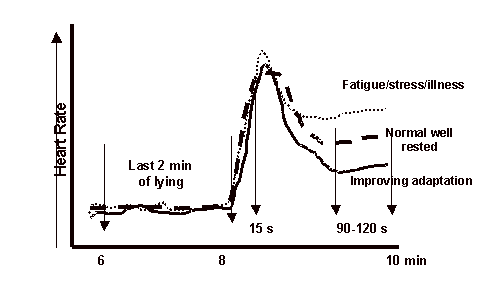
This is a very simple heart rate monitoring test that is currently in use with many athletes around the globe. A detailed method appears below, but essentially all you have to do is lie quietly in a comfortable position for a few minutes and then stand up and remain still for a couple more minutes. The test initiates a heart rate response to the standing motion (and gravity) that the body has to quickly adapt to. Since this test is done under a fairly sensitive control and feedback system, it responds to positive and negative training and competition loads, as well as the onset of illness and other stresses in a fairly sensitive and individualistic way.
Athletes should do this test at least once a week, on a morning when they do not have to rush out of bed. Ideally, it should be done on the same days of the week and in the morning immediately after waking, before the athlete gets out of bed. The test requires very little energy and can easily be done anywhere.
The test usually requires the athlete to have a recording/memory-type
heart rate monitor or a standard display heart rate monitor. If the athlete
does have a recording heart rate monitor, it should be set to record every
5 seconds of the last 4 minute period of the test. If the athlete does
not have a recording heart rate monitor, then the athlete should just
record and calculate 3 data points visually:
Start by lying down and waiting until you are relaxed, and your heart rate
has stabilized. Start
you watch. At
2 minutes stand and stay standing for another 2 minutes. The
important heart rate values are:
1)the average of the 2 minutes of lying,
2)15 seconds after standing and
3)the average of the last 30 seconds of standing (i.e., the 90-120th seconds
after standing).
The following charts give an idea of what data may look like, together with some basic interpretive guidelines.

In the above sample diagram, the suggestion is that a clearly elevated heart rate average between 90 and 120 seconds after standing (i.e., 8-10 beats + above normal) is a possible sign of some failure to recover adequately. This may be due to hard training and poor recovery time, the onset of some illness, or other forms of life stress. On the other hand, if you the heart rate is dropping slightly, then this may be due to some positive adaptation to training and competition. You can also interpret the shape of the heart rate spike caused by standing. A steep climb and quick drop in heart rate indicates a heart that is more rested and sharp than a spike that climbs slowly and descends slowly. Keep in mind that the results are very specific for an individual. No comparisons can be made between athlete's and a profile of each athlete must be made to know what values mean for each person.
This test is used regularly by all of the Canadian National Ski Team athletes to monitor fatigue and adaption levels. It is generally done one day a week, on the same day that other regular testing would be done. It is done before the athlete gets out of bed in the morning. During hard training periods or periods of extreme stress (altitude adaption, travel, training camps, etc...), the test is generally done every day. The national team uses Polar recording heart rate monitors (such as the Polar Accurex Plus) and the data is downloaded and graphed for interpretation by coaches using the Polar computer interface.
The  function on the main header bar produces a heart
rate overlay of all Rusko tests done over the given dates similar to the
one below. This
is useful to compare different tests and see recovery and stress patterns.
function on the main header bar produces a heart
rate overlay of all Rusko tests done over the given dates similar to the
one below. This
is useful to compare different tests and see recovery and stress patterns.
